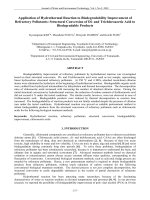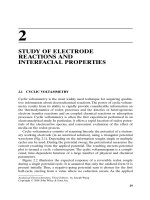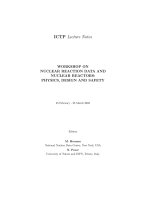Cannizaro reaction
Bạn đang xem bản rút gọn của tài liệu. Xem và tải ngay bản đầy đủ của tài liệu tại đây (3.71 MB, 15 trang )
CANNIZZARO REACTION
In the presence of concentrated alkali, aldehydes
containing no α - Hydrogen undergo self oxidation
& reduction (Redox) reaction to yield a mixture of
an alcohol ( Carbinol ) & a salt of carboxylic acid.
O
2
OH
R
C
OH
O
-
H
R
C
O
R
C
concentrated
carboxylate
anion
www.pdfgrip.com
H
alcohol
H
Examples:
www.pdfgrip.com
MECHANISM OF THE REACTION
1st Mechanism:
O
R
Step I
O
C
H
R
1st aldehyde
molecule
carbonyl-hydroxide
anion
aldehyde-hydroxide
adduct
C
OH
OH
H
conc.
alkali
Tetrahedral intermediate
intermediate I
O
R
C
H
O
O
C
C
R
Step II
OH
R
H
H
H
2nd aldehyde
molecule
O
C
R
OH
intermediate I
OH
O
C
R
H
H
www.pdfgrip.com
alcohol
C
R
O
salt of
carboxylic acid
2nd Mechanism :
Generation of Intermediate I .
Step I
Step II
OH
R
C
OH
H
O
intermediate I
R
C
OH
OH
H
R
C
H
R
O
O
H
O
R
C
O
C
H
How can you prove that the H comes from
another equivalent of aldehyde and not from the
medium, ( i.e. Involvement of a hydride shift in
the mechanism of Cannizzaro reaction) ?
www.pdfgrip.com
O
H
intermediate I
R
C
OH
3rd
H.W.
Mechanism
If the oxidant alde. differs from the reductant
alde. the reaction is Crossed Cannizzaro Reaction.
If one of the aldehydes is formaldehyde , the
reaction yields almost exclusively a salt of formic
acid and the alcohol corresponding to the
other aldehyde.
O
O
OH
R
C
H
H
C
H
H
C
formate
anion
formaldehyde
www.pdfgrip.com
OH
O
-
O
R
C
H
alcohol
H
Aldehydes or ketones with an α – hydrogen undergo
Aldol Condensation ( carbonyl condensation reaction )
faster under the influence of dilute base or acid.
H
O
H 3C
C
H
H
C
O
C
OH
H
OH H
H 3C
H
Acetaldehyde
Acetaldehyde
C
H
H
C
3- hydroxy-butanol
OH
-
Propanal
Acetone
C
O
OH
-
www.pdfgrip.com
?
?
H
Name of Experiment : Cannizzaro Reaction.
Aim of Experiment :Synthesis of Benzoic acid &
Benzyl alcohol
Principals :
Both benzoic acid and benzyl alcohol can be prepared in
the laboratory by Cannizzaro Reaction , by the
action of concentrated NaOH or KOH on benzaldehyde.
O
O
C H
C H
Benzaldehyde
Benzaldehyde
H
O
KOH
C O
conce.
K
Potassium benzoate
www.pdfgrip.com
C OH
H
Benzyl alcohol
Benzoic Acid:
C7H6O2 , C6H5COOH
Molar mass = 122.12 g / mol, Melting point = 121 – 123 oC.
Colorless plate or needle like crystals.
Sparingly soluble in water but soluble in hot or boiled water.
Reacts with NaHCO3 to give CO2 gas.
Used as preservative and antiseptic.
Benzyl Alcohol :
C7H8O , C6H5CH2OH .
Molar mass = 108.14 g / mol , Boiling point = 204 – 207 oC
Colorless oily liquid. Volatile with steam.
Immiscible with water but completely miscible with alcohols
& organic solvents.
Has some local anesthetic properties so used in injectibles
and in ointment as antipruretic & antiseptic.
www.pdfgrip.com
Part I
SYNTHESIS :
www.pdfgrip.com
Part II
Isolation of Benzoic acid & Benzyl
Alcohol :
1- Add 30 ml of H2O to ensure complete dissolve
of Pot. Benzoate.
2- Pour the liquid to a separatory funnel.
3- Add 20 ml ether to the reagent bottle & shake.
4- Add this ether to the liquid in the separatory
funnel.
5- Shake well for 2 min. & stand.
www.pdfgrip.com
www.pdfgrip.com
?
Give the reason for shaking the ethereal
layer with saturated Sodium bisulfite solution in
our experiment today ?
To get rid of excess unreacted benzaldehyde which
may be present.
O
C
H
Na HSO3
O Na
OH
C
C
H
SO3H
H
SO3 Na
?
Why we add Na2CO3 to the ethereal
layer after that?
To get rid of any excess unreacted Sodium bisulfite.
Na2CO3 + 2 NaHSO3
excess
CO2 + H2O + 2 Na2SO3
www.pdfgrip.com
Post Lab Exercises :
?
How would propanal react with KOH under
the condition of this experiment ?
Answer the same question for the reaction of
2,2-dimethylpropanal.
?
In the presence of alkali , Acetaldehyde
undergoes a mixed aldol condensation with
formaldehyde, followed by a crossed Cannizzaro
reaction , to produce the tetra alcohol penta erythritol, C(CH2OH)4 , write the equations .
www.pdfgrip.com
?
In the benzilic acid rearrangement , the
diketone benzil is converted by NaOH into the salt
of benzilic acid. If sodium methoxide (CH3O Na) is
used instead of NaOH, the ester C6H5)2C(OH)COOCH3
is obtained. Suggest a possible mechanism for this
rearrangement.
?4- When o- phthalaldehyde is treated with base,
o- (hydroxymethyl) benzoic acid is formed. Show the
mechanism of this reaction.
CHO
1.
CHO
-
CO2H
OH
2. H3O
+
CH2OH
o-(Hydroxymethyl)
benzoic acid
o-Phthalaldehyde
www.pdfgrip.com









